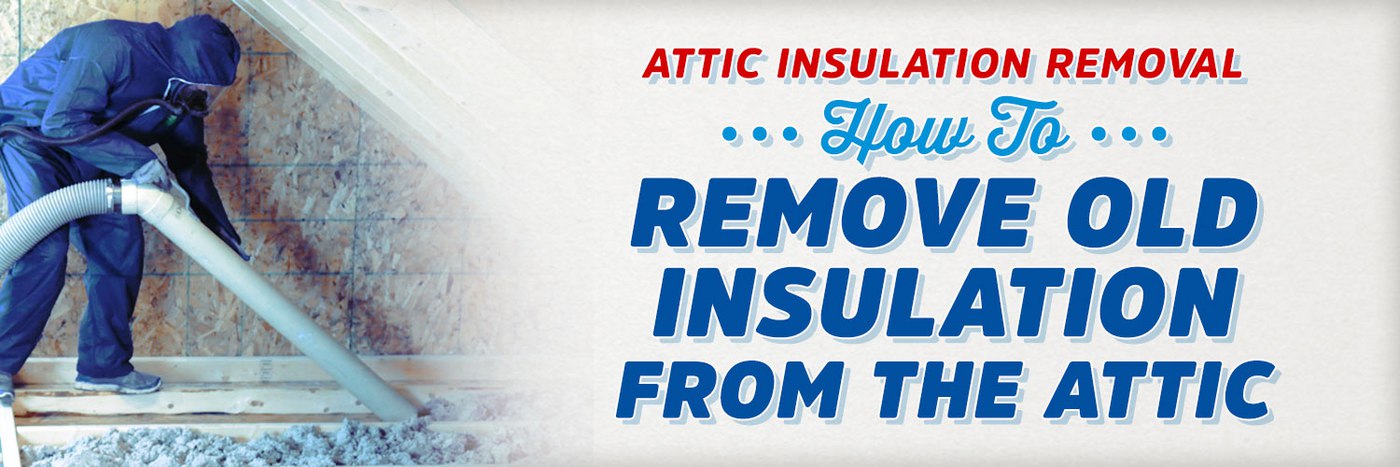Attic Insulation Removal: How to Remove Old Insulation from the Attic


You’re ready to kick that old insulation in your attic to the curb but have no idea where you should start.
That old cellulose or fiberglass in the attic isn’t doing the job anymore, and you’re ready for a change. Whether you’re tired of it all settling to one side or retaining every ounce of moisture, you’re ready for it to go. You want to tackle it on your own, but the research needs to be done before you get your hands dirty.
RetroFoam of Michigan has been spraying foam insulation into homes across the lower peninsula for more than 17 years. Part of that process is sometimes removing traditional insulation before spraying the foam. I have been with the company for more than 5 years and have removed insulation in my fair share of attics.
With the experience I have gained working here, I am going to tell you the best and safest ways to get cellulose and fiberglass out of your attic.
How to Remove Fiberglass Insulation from Your Attic
Removing fiberglass insulation in the attic is a dirty, itchy job, and I highly recommend you get another set of hands to help with removal.
First and foremost, you and your helpers will need the right gear. Fiberglass is made up of very fine glass fibers, so it can embed in your skin and attach to the hair on your arms, eyebrows, and eyelashes. Not to mention if you come into contact with it, you are going to itch like crazy.
Before you get into the attic to start the removal, make sure you have long sleeves, goggles, and paper masks.
When you’re all suited up, it’s time to start the removal process.
You’re going to need enough room to work, and plenty of garbage bags or dumpster space.
I would start with the farthest corner of the attic and begin rolling the batts up, or fold them over, bringing them back towards the access hole. Have your second person bag them up while you’re rolling.
Some attics are small and seem like they will be easy, but it depends on how tight your roof pitch is. That smaller attic can actually take hours because you have to crawl around on your stomach up there.
A bigger roof pitch in a 1,500-square-foot attic, it can be a fairly fast process. Two people could get it done in between 2 to 5 hours. The shorter pitched roof is looking at tacking on a few more hours.
Once everything is all rolled up and bagged, you’re in the clear.
RELATED: Fiberglass Insulation Problems: 6 Things to Watch Out For
How to Remove Blown-In Cellulose Insulation from Your Attic
Our houses generally aren’t airtight, and cellulose insulation can make a mess with even the slightest air movement.
Once you kick up cellulose insulation – which in most cases is recycled newspaper – the dust it creates will make its way down into your house. Before you start the job, you’re going to want to spread plastic over the things in your living space or even a drop cloth. This will save you a little bit of a headache once you have to clean up that dust.
You don’t have to follow the same safety precautions with cellulose that you have to follow with fiberglass. You will need a box or two of masks because the cellulose dust coats them pretty quickly, so you will need to swap them frequently.
The materials needed will require you to do some research. I’ve never seen someone successfully remove cellulose by hand or shovel. It’s going to get everywhere and make an even bigger mess, so you will need to get a vacuum to remove insulation from the attic. We use a 1,500-horsepower shop vac when we do the removal, and in most cases, hook that to a second attic insulation removal vacuum to get the suction we need.
If you don't have a shop vac on hand, most hardware stores offer attic vacuum rental.
You’ll also need some heavy-duty bags to put all that cellulose into. The large garbage bags you get from the hardware store will work, but you will likely use hundreds of them. The bigger and stronger you can find will be the best bet.
Now that you have your materials and tools, let’s talk about the actual removal process.
Even with a vacuum to remove insulation from the attic, the process is pretty long. You will still have to belly crawl along the trusses to vacuum all of the cellulose out. Start at the furthest point from the access hole and work your way backward. This will cut down on the mess, but there will still be dust all over the house, so those drop cloths are important.
In a 1,500-square-foot attic, it could take 6 to 15 hours to remove the cellulose with the proper equipment. It’s going to be an extremely long and dirty process.
With every bag you fill, make sure to squeeze out the air inside before tying the bag shut.
RELATED: Cellulose Insulation Problems: 5 Issues that Could Lead to Disaster
How to Dispose of Old Insulation
Now that you got all of that old fiberglass and cellulose insulation out of your attic, what are you going to do with it?
You can’t sit it out to the road for your local garbage men to pick up.
You’ll have to do more research before you get started. Contact your local waste management authority to see if they take these insulation materials. You will need to drop it off and pay a fee that will vary depending on where you live, which could be several hundred dollars.
Attic Insulation Removal Cost
The cost to remove your attic insulation yourself may end up costing you a lot more than you expect.
This might seem like an easy DIY project, but you must keep in mind you need to buy or rent the right equipment, including a heavy-duty shop vac, large bags, and the cost of old insulation disposal.
You will also want to determine the value of your time, and the time of anyone who volunteers to help you.
Depending on these factors, the size of your attic and how much insulation you need to dispose of, it could easily cost several hundred dollars up to more than $1,000 for the whole removal and disposal project.
What’s Next After Attic Insulation Removal?
Now that you have a clean slate in your attic, you’ll want to seal up that area so your treated air doesn’t escape through the roof.
You removed the cellulose or fiberglass because of the upkeep and other issues you were having with it. If you want to avoid this in the future, there is an insulation that doesn’t need upkeep, creates an air seal, and doesn’t retain moisture.
Spray foam insulation in your attic will create an air seal that will keep your home from leaking the air you are paying to treat. It also keeps your home healthy by not retaining moisture, leading to mold growth, and doesn’t retain allergens.
If you decide foam insulation is the best option for your attic, most spray foam insulation contractors will remove your old attic insulation. This will save you hours of hard and dirty work and the stress of finding a place to dispose of the old insulation.
Related Articles
Why Does Old Insulation Need to be Removed from the Attic Before Installing Spray Foam?
How Much Insulation Do I Need in My Attic?
About Jacob Stacy
Jacob has been with the company for more than 4 years and has worked as an estimator, installer, and in the office. This experience lends itself to his current position as a customer support concierge when answering customers questions. With 10 years of building and manual labor experience, Jacob has the unique ability to answer questions in detail when scheduling appointments. He also has the capabilities to jump onto a truck and help with installation at a moments notice when needed. In his free time, Jacob enjoys spending time with his twin boys and teaching them about the world around them.


